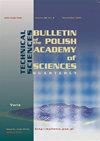在心率变异性中使用可穿戴传感器的缺失数据输入
IF 1.1
4区 工程技术
Q3 ENGINEERING, MULTIDISCIPLINARY
Bulletin of the Polish Academy of Sciences-Technical Sciences
Pub Date : 2023-11-06
DOI:10.24425/BPASTS.2020.133118
引用次数: 2
摘要
这项工作的目的是建立一种考虑连接的心跳传感器丢失数据的方法,以便在心率变异性(HRV)计算的背景下提出一种良好的替代方法。该框架是一个研究项目,旨在建立一个系统,可以测量压力和其他因素影响心脏病的发生和发展。这项研究包括研究现有的方法,并通过使用描述参与者日常生活的案例研究的实验数据来改进它们。我们进行了一项研究,通过心率波动信号模拟压力,该信号是从连接到智能手表的心率监测带中提取的。本文描述了数据记录过程和数据输入方法。丢失数据是一个已经被许多作者讨论过的话题。文章解释了为什么我们选择样条插值进行数据值的插补。我们实现了一个随机抑制数据的程序,并模拟了去除的数据。之后,我们实现了几种算法,并根据均方误差为我们的案例研究选择了最好的算法。本文章由计算机程序翻译,如有差异,请以英文原文为准。
Missing-data imputation using wearable sensors in heart rate variability
The objective of this work is to set up a methodology that considers missing data from a connected heartbeat sensor in order to propose a good replacement methodology in the context of heart rate variability (HRV) computation. The framework is a research project, which aims to build a system that can measure stress and other factors influencing the onset and development of heart disease. The research encompasses studying existing methods, and improving them by use of experimental data from case study that describe the participant’s everyday life. We conduct a study to modelize stress from the HRV signal, which is extracted from a heart rate monitor belt connected to a smart watch. This paper describes data recording procedure and data imputation methodology. Missing data is a topic that has been discussed by several authors. The manuscript explains why we choose spline interpolation for data values imputation. We implement a random suppression data procedure and simulate removed data. After that, we implement several algorithms and choose the best one for our case study based on the mean square error.
求助全文
通过发布文献求助,成功后即可免费获取论文全文。
去求助
来源期刊
CiteScore
2.80
自引率
16.70%
发文量
0
审稿时长
6-12 weeks
期刊介绍:
The Bulletin of the Polish Academy of Sciences: Technical Sciences is published bimonthly by the Division IV Engineering Sciences of the Polish Academy of Sciences, since the beginning of the existence of the PAS in 1952. The journal is peer‐reviewed and is published both in printed and electronic form. It is established for the publication of original high quality papers from multidisciplinary Engineering sciences with the following topics preferred:
Artificial and Computational Intelligence,
Biomedical Engineering and Biotechnology,
Civil Engineering,
Control, Informatics and Robotics,
Electronics, Telecommunication and Optoelectronics,
Mechanical and Aeronautical Engineering, Thermodynamics,
Material Science and Nanotechnology,
Power Systems and Power Electronics.

 求助内容:
求助内容: 应助结果提醒方式:
应助结果提醒方式:


